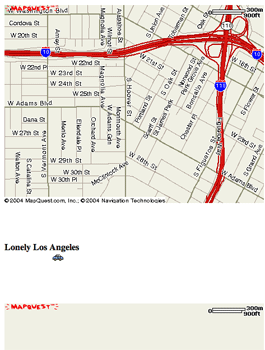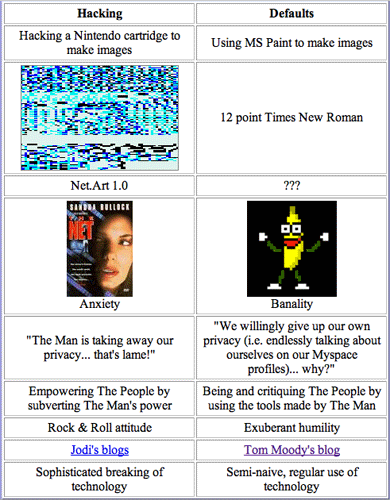The Age of Mammals is an apt title for Guthrie Lonergan's website. His emerging body of work, with its thoughtful and frequently humorous appropriation and repurposing of online idioms, is like a wunderkammer of life lived publicly on the web, a vast diorama of default settings. A founding member of the internet surfing club Nasty Nets, he was recently featured in the Montage: Unmonumental Online exhibition at the New Museum. -- Thomas Beard

Guthrie Lonergan, Lonely Los Angeles, 2005
Earlier today I revisited Lonely Los Angeles (2005), the piece where you assembled MapQuest renderings of meandering, isolated expanses of SoCal roadway, and it got me thinking about how the cultural and political geography of the city has, historically, cast such a large shadow over artists working there. How do you think living in LA has influenced your work, directly or obliquely, if at all?
Honestly, I haven't quite figured LA out yet, and I feel a bit out of place no matter where I am. Aesthetically there are some parallels-- I love the way LA looks, the flatness and the plainness of all the buildings. Well-lit but boring (in a good way). (The people aren't always as humble as the architecture...!) Every other city I've been to kind of reminds me of New York, ancient buildings with lots of details, dark. I actually made Lonely Los Angeles before I learned to drive, so in a way I was using the computer lab to cruise around the city.
Your work has also made use of a wide range of popular forms that have taken root within the vernacular web, from the group portrait shot to MySpace intros. In what ways are these materials significant to you as folk art? Are there other, analogous modes of expression online that have been of interest to you lately?
Those forms you mentioned are interesting to me as whole groups, but I have trouble thinking about them as individual videos or photos... I guess a lot of my work approaches the Internet as though it is one singular being (whoa). But I explored Internet folk art in a series of lectures I did a while back, and it's generally an inspiration. Mostly I'm interested in the "Do It Yourself" thing juxtaposed with corporate defaults, the tension of an individual attempting to express themselves through YouTube, MySpace, Apple, etc., something exciting and full of life trying very hard to come through a banal structure. I'm pretty skeptical of the goals of Web 2.0, the almost religious obsession with freedom, all the utopian democratic nonsense... And I think it's hilarious to hear that phrase--"DIY"-- all the time now, because it makes me think of Punk, and the web is so mild and boring... I should admit I've been really into the current Web 2.0 fad Twitter, the challenge of summarizing your life into stupid little one-liners. It always reads like poetry, Internet haiku... (btw, online karaoke is totally the next big thing...)-->-->

Guthrie Lonergan, Hacking vrs. defaults chart, 2007
Along those lines, your Hacking vrs. defaults chart (2007) is a personal favorite. It's such a perspicacious comment on how the ethos of internet-based art practices have evolved, with columns cleverly contrasting two differing sensibilities. In one row, for instance, we have "Net.Art 1.0," in the other, "???." Is it possible to articulate what that "???" is now, or does it remain, in its own way, unanswerable?
It's hard to pin down that "???," even within such a specific thing as Nasty Nets, and the people involved with Nasty Nets... I think a lot of these artists are going in subtly different directions, though we share an interest in what the Internet has done to us, how it affects culture and consciousness-- often the art is much more about people than about technology, which is great, because I feel like this is where most media art gets tripped up... But there is no coherent movement. And often the only thing that makes what we're doing "net art" is that we exhibit it online first. Like the reverse of "normal" art: documentation before exhibition.
How did Nasty Nets first come about? What have you found interesting about the ways the project has developed since its inception, and how do you see it as similar to or distinct from other surfing clubs?
In early 2006, I wanted to start some kind of Internet surfing community site with surf buddies John Michael Boling and Joel Holmberg. We rolled around a ton of different complex structural ideas, but we eventually decided to simply start a blog (duh). Marisa Olson helped us get it going... Basically, Nasty Nets was all the surfers I'd met through trading links on del.icio.us who'd already been developing a special "taste" in surfing: a fascination with defaults and a certain kind of banal deadpan. (I'll point to Travis Hallenbeck as the obvious best example of this kind of surfing.) It seemed like a wonderfully unpretentious and playfully nerdy thing to do, for artists who live in different parts of the world to unite though an online club. (Of course collectives Beige and Paper Rad were big influences here...) I love that every surf club seems to develop its own rhythm, even without setting forth any official goals or rules something coherent seems to develop organically (like a band). I think after a while, a lot of us felt like NN lost that rhythm and got too big... I've been praying that new surf clubs would pop up in its (temporary?) absence-- I'm really stoked for Kevin [Bewersdorf] and Paul [Slocum]'s new surf club, Spirit Surfers!
It seems there's a lot of ink being spilled these days on the archival impulse in contemporary art. I'd be curious to hear your thoughts on how you see your role as a collector relating to your work as an artist.
My whole art practice and art world grew out of intense Internet surfing, collecting and trading links on del.icio.us… Part of it is the feeling that there's so much stuff out there already that it seems pointless to make something new, from scratch-- which is perhaps a bit of a cliché response, but not untrue. The ephemeral nature of the Internet inspires a kind of disrespect for objects-- for for whole, perfect, "created" things. I'm really happy that, when someone comes to my website, my "portfolio" or whatever, they're basically just confronted with a list of lists-- and I like that they might leave thinking, "what did that guy really even do?" Even the word "collecting" implies too much physicality or weight; it's more like pointing or listing. In this way it's different than pre-Internet appropriation, because there's absolutely nothing precious or special to me about my specific source materials. We can all Google whatever the hell we want.
You recently told me that you were working on some ideas for "offline art." Care to elaborate on what shape they might take?
Right now I'm scheming how to take the emphasis off of the Internet and technology, but keep my ideas intact. Objects that aren't objects... I got a couple of books and a t-shirt in the works. Right now I'm really into text (not visually/typography... just... text...), and lots and lots of lists… "Internet Aware Art." :)
Thomas Beard is a founder and director of Light Industry. From 2005-2006 he was Program Director of Ocularis, a series for artists' film and video in Brooklyn, New York. He also served as a programmer at Cinematexas as well as a programming consultant at the Internationale Kurzfilmtage Oberhausen, and has organized screenings and exhibitions at Art in General, Aurora Picture Show, the New York Underground Film Festival, Mass Art Film Society, the Museum of Modern Art, and the University of California, Berkeley Art Museum and Pacific Film Archive. Most recently he is the editor of Live Cinema: A Contemporary Reader, which will be published by San Francisco Cinematheque later this year.


Go, Guthrie!
But…
Curious why the Hacking vs Defaults chart was edited–shouldn't it say "detail"?
Here is a link to full chart and some actual (gasp) discussion about it: http://guthguth.blogspot.com/2007/01/hacking-defaults-hacking-nintendo.html
Thanks for uncropping.
Exuberantly humbly,
Tom
PS I would say the people in Nasty Nets are going in radically different directions. One thing that made the site interesting was that there was enough shared interest in defaults and web junk for it to be self-moderating for quite a while. I am alone, I think, in actually enjoying the fights that broke out all too rarely.
We couldn't even discuss whether a photo of a giant cell phone smashing into a car was "good" or "bad" without people getting "sad and angry."
Thanks for uncropping.
Exuberantly humbly,
Tom
PS I would say the people in Nasty Nets are going in radically different directions. One thing that made the site interesting was that there was enough shared interest in defaults and web junk for it to be self-moderating for quite a while. I am alone, I think, in actually enjoying the fights that broke out all too rarely.
We couldn't even discuss whether a photo of a giant cell phone smashing into a car was "good" or "bad" without people getting "sad and angry."